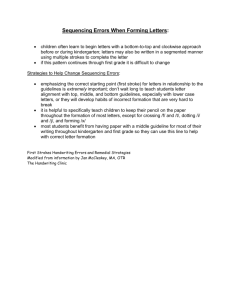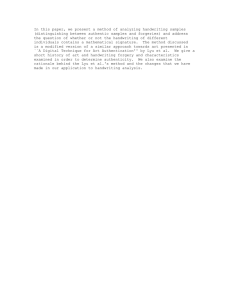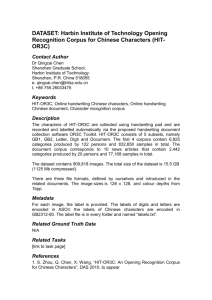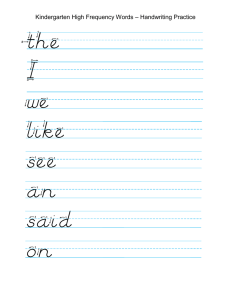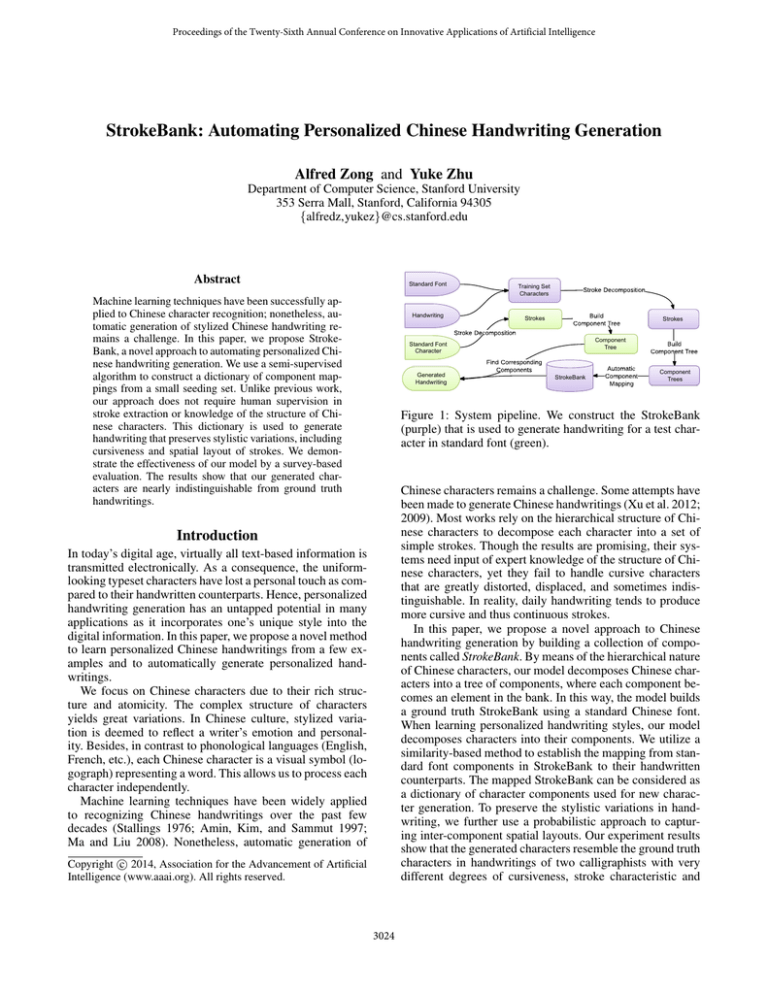
Proceedings of the Twenty-Sixth Annual Conference on Innovative Applications of Artificial Intelligence
StrokeBank: Automating Personalized Chinese Handwriting Generation
Alfred Zong and Yuke Zhu
Department of Computer Science, Stanford University
353 Serra Mall, Stanford, California 94305
{alfredz,yukez}@cs.stanford.edu
Abstract
Standard Font
Machine learning techniques have been successfully applied to Chinese character recognition; nonetheless, automatic generation of stylized Chinese handwriting remains a challenge. In this paper, we propose StrokeBank, a novel approach to automating personalized Chinese handwriting generation. We use a semi-supervised
algorithm to construct a dictionary of component mappings from a small seeding set. Unlike previous work,
our approach does not require human supervision in
stroke extraction or knowledge of the structure of Chinese characters. This dictionary is used to generate
handwriting that preserves stylistic variations, including
cursiveness and spatial layout of strokes. We demonstrate the effectiveness of our model by a survey-based
evaluation. The results show that our generated characters are nearly indistinguishable from ground truth
handwritings.
Handwriting
Training Set
Characters
Strokes
Strokes
Component
Tree
Standard Font
Character
Generated
Handwriting
StrokeBank
Component
Trees
Figure 1: System pipeline. We construct the StrokeBank
(purple) that is used to generate handwriting for a test character in standard font (green).
Chinese characters remains a challenge. Some attempts have
been made to generate Chinese handwritings (Xu et al. 2012;
2009). Most works rely on the hierarchical structure of Chinese characters to decompose each character into a set of
simple strokes. Though the results are promising, their systems need input of expert knowledge of the structure of Chinese characters, yet they fail to handle cursive characters
that are greatly distorted, displaced, and sometimes indistinguishable. In reality, daily handwriting tends to produce
more cursive and thus continuous strokes.
In this paper, we propose a novel approach to Chinese
handwriting generation by building a collection of components called StrokeBank. By means of the hierarchical nature
of Chinese characters, our model decomposes Chinese characters into a tree of components, where each component becomes an element in the bank. In this way, the model builds
a ground truth StrokeBank using a standard Chinese font.
When learning personalized handwriting styles, our model
decomposes characters into their components. We utilize a
similarity-based method to establish the mapping from standard font components in StrokeBank to their handwritten
counterparts. The mapped StrokeBank can be considered as
a dictionary of character components used for new character generation. To preserve the stylistic variations in handwriting, we further use a probabilistic approach to capturing inter-component spatial layouts. Our experiment results
show that the generated characters resemble the ground truth
characters in handwritings of two calligraphists with very
different degrees of cursiveness, stroke characteristic and
Introduction
In today’s digital age, virtually all text-based information is
transmitted electronically. As a consequence, the uniformlooking typeset characters have lost a personal touch as compared to their handwritten counterparts. Hence, personalized
handwriting generation has an untapped potential in many
applications as it incorporates one’s unique style into the
digital information. In this paper, we propose a novel method
to learn personalized Chinese handwritings from a few examples and to automatically generate personalized handwritings.
We focus on Chinese characters due to their rich structure and atomicity. The complex structure of characters
yields great variations. In Chinese culture, stylized variation is deemed to reflect a writer’s emotion and personality. Besides, in contrast to phonological languages (English,
French, etc.), each Chinese character is a visual symbol (logograph) representing a word. This allows us to process each
character independently.
Machine learning techniques have been widely applied
to recognizing Chinese handwritings over the past few
decades (Stallings 1976; Amin, Kim, and Sammut 1997;
Ma and Liu 2008). Nonetheless, automatic generation of
c 2014, Association for the Advancement of Artificial
Copyright Intelligence (www.aaai.org). All rights reserved.
3024
The StrokeBank Model
component layout. Fig. 1 shows our system pipeline.
Our major contributions to Chinese handwriting generation are twofold: 1) components instead of simple strokes
are used to capture the cursiveness of handwriting characters; 2) a semi-supervised framework is introduced to construct StrokeBank with minimum human supervision.
Problem Formulation
We propose a component-based model to tackle the Chinese
handwriting generation problem. We first build a StrokeBank containing a collection of components in a standard
Chinese font mapped to handwritten components. During
generation, our StrokeBank is used as a dictionary to retrieve
handwritten components from the standard font.
Related Work
Handwriting generation is an active research field in the last
decade. In this section, we briefly introduce recent works in
handwriting synthesis in other languages, and discuss works
in Chinese handwriting generation in greater detail.
Stroke Extraction
We use a stroke extraction approach similar to (Cao and Tan
2000). For each character pixel in the bitmap, we calculate
the orientation distances, the boundary-to-boundary distance
on a line that passes through the pixel. We quantize the orientation space [0, π) for each pixel into 40 bins. Given the
distribution of orientation distances, we find all crests by taking the mean of all distances as a threshold. Each crest represents a possible orientation of the stroke. For example, for
a pixel in the character 一 (Yi), it has one crest; for a pixel
at the intersection in character 十 (Shi), it has two crests.
Finally, we merge all the possible orientations into a binary 3D space called ρ-space. Each element (x, y, m) is 1
iff the orientation m is in one of the crests of pixel (x, y).
An example of a ρ-space is shown in Fig. 2. By looking for
connected components in the ρ-space, we are able to find all
the strokes of a Chinese character.
Handwriting Generation
Researchers have made efforts in handwriting generation in
various languages. The majority of existing algorithms focus on English (Lin and Wan 2007; Graves 2013), where the
cursiveness and spatial layout are relatively simple, while
only a few attempts have been made to synthesize languages (e.g. Indian languages, Korean, Arabic) with more
complex characters (Jawahar and Balasubramanian 2006;
Lee and Cho 1998; Dinges et al. 2011). However, most models deal with characters with relatively simple structure and
with limited cursiveness. On the other hand, the complex
layouts and variations in Chinese characters demand a more
elaborate model to generate handwritings with high fidelity.
Chinese Handwriting Generation
Research in Chinese handwriting generation has largely focused on the automatic synthesis of artistic calligraphy (Xu
et al. 2005). The most related work to ours is from (Xu et
al. 2009), which uses a shape grammar rule to decompose
words into a hierarchical representation. It then generates
stylized characters by maximizing a likelihood estimate that
captures personalized handwriting characteristics. However,
there are three major drawbacks to the model: 1) it makes
strong assumptions on the structure of handwriting characters, which do not hold for joined-up writing, where the
strokes are largely cursive and connected; 2) expert knowledge is required to design a complete set of shape grammars;
3) human supervision is needed to correctly extract strokes
so the shape grammars can be applied.
In contrast, our model aims to construct a StrokeBank
with little human supervision. Instead of applying expert
knowledge to decompose Chinese characters, we propose an
automatic approach to extracting component and building a
StrokeBank for handwriting generation.
Figure 2: ρ-space and strokes of character 于 (Yu). Color
indicates orientation (z-axis): blue for 0 and red for π.
Component Tree Generation
After stroke extraction, we build a tree representing the
structure of the character at different decomposition levels.
Since it is possible to decompose the character in different
ways, for each character we generate a forest consisting of
variations of trees. Each tree is constructed bottom-up, with
leaves being the most finely decomposed strokes. Strokes
are grouped together based on simple heuristics, for example, when they cross each other, share the same joint, or lie
in close proximity with one another. Finally, the root of a
tree is the whole character itself. Fig. 3 shows a tree learned
from decomposing a Chinese character 说 (Shuo).
Stroke Extraction
Stroke extraction is usually the first step in analyzing Chinese characters. A model to utilize degree information and
stroke continuation property was proposed to perform stroke
segmentation (Cao and Tan 2000). This model addresses
two major problems in stroke extraction: identifying primary
strokes and resolving ambiguities at intersection points.
(Liu, Kim, and Kim 2001) proposed a model-based algorithm to extract strokes and inter-stroke relations by matching them with a reference character described in an attributed relational graph.
Feature Extraction
We extract two features from each component in the tree.
3025
Automatic Component Mapping
Given two collections of component trees (i.e. two forests)
generated for a standard Chinese font and a particular handwriting, we would like to automatically learn a mapping
function between components in the standard font and its
handwritten counterparts. We solve the mapping problem in
a semi-supervised framework (Zhu 2005). A small set of
manual mapping is used with a large amount of unlabeled
data to learn a robust and reliable mapping function.
Figure 3: A tree of components obtained from one possible
decomposition of a Chinese character 说 (Shuo).
Mapping of the DEF vector The DEF vector captures the
stroke orientation information of a component. Here, we assume that the DEF vector of handwritings can be approximated by an affine transform of the DEF vector of the standard font. This assumption is reasonable, especially for components consisting of strokes that have little curvature. As a
simple example, the character 十 (Shi) usually has a perfectly horizontal and a perfectly vertical stroke in the standard font. However, in most handwritings, the horizontal
stroke is tilted but the vertical stroke remains perfectly vertical. An affine transform is capable of capturing this rotational variation. Though for more complicated components,
this assumption does not capture all the nuances in the mapping from standard font to a handwriting, in practice our
model performs well.
We adopt a multivariate linear regression model to learn
the affine transform. Given a standard font component X (i)
and its mapped handwritten component Y (i) , let f (X (i) )
and f (Y (i) ) be the DEF feature vectors. Our hypothesis says
f (Y (i) ) = θf (X (i) ), and the closed form solution is:
Directional element feature (DEF) The directional element feature vector is well suited to describe stroke-based
characters (Kato et al. 1999), such as those in Chinese and
Japanese. Similar to the procedure proposed by Kato et al.,
the contour of a component is computed (Fig. 4). Then for
each black pixel centered in a 3 × 3 mask, we assign a direction or a combination of directions. We only consider four
spatial orientations: horizontal, vertical, left- and right diagonals. To improve robustness against spatial dislocation,
we perform spatial pooling (Fig. 4) by counting the number
of each orientation assigned to the black pixels in a subregion. If we denote the feature vector of each subregion by
x1 , . . . , x4 where xi is the count of black pixels assigned
with direction i, we compute xi as
(A)
xi = xi
(B)
+ 2xi
(C)
+ 3xi
(D)
+ 4xi
, i = 1, . . . , 4.
(1)
As we use 49 subregions, the final DEF feature vector has
196 dimensions.
θ = (µI + f (X )T f (X ))−1 f (X )T f (Y)
160 pixel
where µ is the regularization parameter and I is the identity
matrix. X and Y represent the collection of all labeled components in the standard font and a particular handwriting.
Thus, the i-th row in f (X ) represents f (X (i) ); the same for
f (Y). During training, we use cross-validation to choose the
appropriate value of µ. We set µ ∼ ||f (X )T f (X )||F , where
|| · ||F stands for the Frobenius norm.
A
B
D
40 pixel
160 pixel
40 pixel
C
(2)
Weighted affinity of the full feature vector Successful
automatic mapping heavily relies on a good affinity measure between the full feature vectors including both DEF and
Fourier spectra.
One naı̈ve way is to compute a distance measure (e.g. Euclidean and χ-square) between the affine transformed feature of standard font component and the feature of handwritten component. However, this approach performs poorly
due the varying dimensions and scales of different features
in the concatenation. Methods in combining multiple types
of features have been recently proposed (McFee and Lanckriet 2011; Song and Zhu 2013; Wang et al. 2014). Here, we
propose an optimization approach that learns weights w for
each feature dimension.
Let φ(X (i) ) and φ(Y (i) ) be the full feature vectors of X (i)
and Y (i) . As discussed, the first 196 dimensions of φ(·) is
the DEF vector f (·) and the rest is the Fourier spectra vector.
Let Θ be the affine transform operator as discussed in the
previous subsection. Note that Θ only operates on the DEF
Figure 4: Left: the contour of a character 黄 (Huang) placed
in an 8 × 8 grid. Right: the schema for spatial pooling of
direction elements in each subregion (Kato et al. 1999).
Fourier spectra The second feature is constructed from
the Fourier spectra of the component bitmap. Inspired by
the application of Fourier spectra in face recognition (Spies
and Ricketts 2000), we build a 2k dimensional vector using
both the real and imaginary parts of the top k most variant
frequencies from the lower quadrant. The DC component is
set to zero in order to minimize the negative effect of spatial
displacement. We adopt k = 20 in our model.
The final representation is the concatenation of DEF and
Fourier spectra vectors. The full feature vector therefore has
196 + 40 = 236 dimensions.
3026
vector while leaving the Fourier spectra vector unchanged.
In matrix representation,
θ 0
Θ=
.
(3)
0 I
Hui Gong Grid, which were developed by a famous Chinese calligraphist Weiguo Yang to better visualize the structure of Chinese characters. Specifically, strokes extending to
the outskirt define the overall aesthetics of the character, and
contribute more to its defining characteristics. On the other
hand, strokes in the core region are more compact and subject to deformation, hence adding more noise to the DEF
feature and getting less weight.
Let the weighted distance metric between any pair of
components in the standard font X and a handwriting Y be
dist(Θ(X), Y ) =
d
X
j=1
wj |(Θφ(X))j − φ(Y )j |
(4)
160 pixel
where d is the dimension of the full feature vector and
wj , (Θφ(X))j and φ(Y )j are the j-th component in the
vector. dist(Θ(X), Y ) can also be written as wT D(X, Y ),
where D(X, Y ) = |(Θφ(X))j − φ(Y )j |, j = 1, 2, . . . d.
If X (i) and Y (i) correspond to the same component, we want dist(Θ(X (i) ), Y (i) ) to be smaller than
dist(Θ(X (i) ), Y ), ∀Y 6= Y (i) . Therefore, we formulate the
learning problem in the following quadratic programming
(QP) scheme:
X
λ
w∗ = arg min wT w +
ξi
(5)
w,ξ 2
i
160 pixel
Core
Outskirt
Figure 5: Labeled outskirt and core regions of a character 恕
(Shu). Two bold borders resemble Hui Gong Grid.
such that
Handwriting Generation
wT D(X (i) , Y (i) ) − wT D(X (i) , Y ) ≥ 1 − ξi , ∀Y 6= Y (i)
Once we have the mapping dictionary, we are able to generate new personalized handwriting. Given an input character, we first decompose it into a set of components
{Z (1) , Z (2) , . . . , Z (m) }. Since each component consists of
a set of basic strokes S, let S (i) be the set of basic
strokes Z (i) covers. We want to find a set of components
{Z (a1 ) , Z (a2 ) , . . . , Z (an ) } such that S = S (a1 ) ∪ S (a2 ) ∪
· · · ∪ S (an ) and S (ai ) ∩ S (aj ) = ∅ for i 6= j. We measure the similarity from Z (k) to an entry in the dictionary
(X (i) , Y (i) ) as:
and ξi ≥ 0,
∀i
where λ is the regularization parameter, ξi is the slack variables for handling soft margins, and i goes through all the
labeled mappings. The optimization problem in Eq. (5) is
equivalent to w∗ = arg minw,ξ λ2 wT w+R(w), where R(w)
defines a hinge loss function:
X
R(w) =
max(0, R(i) (w)), where
i
h
i
R (w) = max 1+wT D(X (i) , Y (i) ) − D(X (i) , Y )
(i)
s(Z (k) , X (i) , Y (i) )
Y 6=Y (i)
The optimization problem is convex and we solve it with an
off-the-shelf solver (Do 2009). Table 1 compares the error
rates of our automatic mapping before and after using the
weights w∗ . The improvement is clear.
= e−||f (Z
)−f (X (i) )||2
+e−dist(Θ(X
(i)
),Y (i) )
+ν|S (k) |
where f (·) is the DEF vector, |S (k) | is the cardinality of
the set S (k) and ν is a positive constant. The ν|S (k) | term
models the desired behavior that if we manage to find a
well matched component that consists of many strokes in
the dictionary, we bias towards using this larger component.
This biased selection will be robust against cursive handwriting for which substituting individual strokes would result in a disconnected, unnatural character as a whole. Formally speaking, the bias preserves more correlation such as
relative spatial position, size, and orientation between individual strokes. We adopt ν = 0.2 in our experiment.
The generation problem is reduced
Pn to finding a valid set
A = {a1 , a2 , . . . , an } such that j=1 s(Z (aj ) , X (i) , Y (i) )
is maximized. Solving the exact inference problem is NPhard; we adopt an efficient greedy forward search approach.
Once we retrieve these handwritten components, we align
them based on the centroid of the original component.
Table 1: Mapping Error Rate
without w∗
with w∗
(k)
4.63%
0.77%
Interpretation of the weighted affinity A larger weight
in w∗ corresponds to a more discriminative feature dimension. One interesting observation is that the average weight
∗
woutskirt
for DEF features in the outskirt of a character is
∗
much larger than that in the core area wcore
, where core and
outskirt regions are labeled in Fig. 5. The larger weight distribution towards the outskirt agrees with the finding of previous work (Kato et al. 1999) and agrees with theories of
3027
Shan
Shan
Hu
Hu
Ru
Ru
Yi
Yi
Ye
Chun Feng
Lai
Qian
Shu
Wan
Shu
Li
Ye
Chun Feng
Lai
Qian
Shu
Wan
Shu
Li
(a) An excerpt from a Tang poem “˝Ç ⌧%ŒeC⌘⌥⌘®± ”.
(a) An excerpt from a Tang poem “˝Ç ⌧%ŒeC⌘⌥⌘®± ”.
Hua
Hua
Kai
Kai
Bu
Bu
Zai
Gao
You
Xian
Ze
Ming Shui
Bu
Zai
Shen
You
Long
Zai
Gao
You
Xian
Ze
Ming Shui
Bu
Zai
Shen
You
Long
(b) An excerpt from an famous essay Lou Shi Ming: “q (ÿ Ÿ⇡ 4 (Ò ô⇡u”.
(b) An excerpt from an famous essay Lou Shi Ming: “q (ÿ Ÿ⇡ 4 (Ò ô⇡u”.
Ze
Ze
Ling
Ling
Figure 6: Generated handwritten characters using our StrokeBank approach, as compared to the ground truth. In both (a) and
Figure
handwritten
characters
our
StrokeBank
as
ground
In In
both
(a)(a)
and
(b), the
1ststGenerated
and 2nd
rows
are written
in Xing, using
and 3rd
and
4th
rows inapproach,
Shou Jin. For
each font,tothe
first
line istruth.
generated
while
theand
Figure
6: 6:
Generated
our
StrokeBank
approach,
ascompared
compared
tothe
the
ground
truth.
both
nd handwritten characters using rd
th
(b),
the
1
and
2
rows
are
written
in
Xing,
and
3
and
rows
in ShouofJin.
Forcolumn.
is generated while the
therows
ground
Phonetic
labels
the bottom
each
(b),second
the 1stline
andis2nd
aretruth.
written
in Xing,
andare
3rd shown
and 44thatrows
in Shou Jin.
Foreach
eachfont,
font,the
thefirst
firstline
line
is generated while the
second line is the ground truth. Phonetic labels are shown at the bottom of each column.
second line is the ground truth. Phonetic labels are shown at the bottom of each column.
Metric
Metric
ments.the
Two
handwriting
Xing and Shou
Jin, are is
used
Since
exact
quality of styles,
computer-generated
characters
Since
exact Xing
quality
computer-generated
is for
for evaluation.
is of
cursive,
while Shoumethod
Jincharacters
is notable
hard
tothe
measure,
we conduct
a survey-based
to quanhard
to measure,
we conduct
survey-based
method
quanthe unique
endpoints
in its astrokes.
Themodel.
characters
we used
titively
evaluate
the
effectiveness
of our
Wetoinvited
titively
evaluate
the
effectiveness
oftohandwritings
our
model. We
20
well-educated
Chinese
scholars
distinguish
generated
in Xing
and Shou
Jin
are based
on
ofinvited
Jinsheng
20
Chinese
scholars
to distinguish
characters
from ground
truth
handwritten
characters.
The reQiuwell-educated
and Yingzhang
Tian
respectively;
both
are generated
well-known
characters
from
ground
truth
handwritten
characters.
The respondents
are first
given
20Shou
sample
truth handwriting
calligraphists.
Xing
and
Jinground
are chosen
because
they
spondents
are
first
given
20
sample
ground
truth
handwriting
characters
of
each
style
as
reference.
They
are
then
shown
represent very different handwriting styles in terms of acurcharacters
of characters,
eachcharacteristics,
style as
reference.
areand
thengenerated
shown a
sheet
of 100
mixing
ground
truth
siveness,
stroke
andThey
component
layouts.
almost all components, (x, y) is clustered around (xo , yo )
almost
components,
(x,
is model
clustered
around
(xo , yo )
in
very all
close
proximity;
we y)
thus
as
a multivariate
Modeling
stylistic
variations
The
sameP
written
in
very close
proximity;
we F.
thus
model
Pcharacter
as a multivariate
Gaussian
independent
from
by Gaussian
the same independent
person can vary
in
shape
from
time
to
time
due
from the
F. positions of the same radical
We train
P by observing
to intrinsic
uncertainties
in human
handwriting. We capture
We
train Pinby
observing
the positions
of
the handwriting.
same radical
appears
different
characters
of thethe
same
thisthat
slight
variation
in styles
by learning
probability
disthat
appears
in
different
characters
ofgenerally
the same located
handwriting.
Radicals
are
chosen
because
they
are
inFor
the
tribution
of
the
position
of
a
component
in
the
character.
Radicals
are chosen
because
they
are generally
located
in the
same
position
despite
drastic
variations
in
other
parts
of
the
a particular
component,
let P(x,
y|xo , yoin
, F)
be parts
the probasame
position
despite deviation
drastic
variations
other
of
the
character.
A
standard
of
roughly
2
pixels
in
either
bility
of it being
written deviation
at positionof(x,
y), given
the standard
character.
A standard
roughly
2 pixels
either
xor y-direction
is obtained, which
is applied
to in
aligning
position
(xo , yo ) andis some
generic
features
of the
compox- or
y-direction
obtained,
which
is applied
to standard
aligning
the
centroid
of a retrieved
component
away
from its
nent
F,
such
as
the
combined
DEF
and
Fourier
spectra
vecthe
centroid
of a retrieved
position
according
to P. component away from its standard
tor.position
All positions
refertotoP.the coordinates of the centroid. For
according
almost all components, (x, y) is clustered around (xo , yo )
in very close proximity;Evaluations
we thus model P as a multivariate
Evaluations
Gaussian independent from
F.
Datasets
We
train P by observing the positions of the same radical
thatDatasets
appears in different characters of the same handwriting.
We useare
Kai,
a publicly
available
as our located
standardinfont
Radicals
chosen
because
they arefont,
generally
the
We
use Kai,
awidely
publicly
available
font,
asand
our official
standarddocufont
because
it
is
seen
in
presswork
same
position
despite
drastic
variations
in
other
parts
of
the
because
it ishandwriting
widely seen
in presswork
ments. Two
styles,
Xing and and
Shouofficial
Jin, aredocuused
character.
A standard
deviation
roughly
2 pixels
in
ments.
Two
handwriting
styles,ofwhile
Xing
and Shou
areeither
used
for evaluation.
Xing is cursive,
Shou
Jin isJin,
notable
for
x- for
or y-directionXing
is obtained, which
isShou
applied
aligning
whileThe
Jin istonotable
for
the evaluation.
unique endpointsisincursive,
its strokes.
characters
we used
thethe
centroid
ofendpoints
a retrieved
awaycharacters
from its
unique
in component
its
strokes.
The
we used
in
Xing
and
Shou
Jin are
based
on handwritings
of standard
Jinsheng
position
according
P.
in
and
ShoutoJin
are based
on handwritings
of Jinsheng
QiuXing
and
Yingzhang
Tian
respectively;
both are well-known
Qiu
and
Yingzhang
Tian
respectively;
both
are
well-known
calligraphists. Xing and Shou Jin are chosen because they
calligraphists.
and handwriting
Shou Jin arestyles
chosen
because
Evaluations
represent very Xing
different
in terms
of they
currepresent
very different
handwriting
styles in terms
of cursiveness,
stroke
characteristics,
and
component
layouts.
Datasets
siveness, stroke characteristics, and component layouts.
We use Kai, a publicly available font, as our standard font
because it is widely seen in presswork and official docu-
sheet
100are
characters,
ground truth
and generated
ones. of
They
asked to mixing
judge whether
a character
is genones.
They
are askedthe
to identification
judge whetheraccuracy
a character
is generated.
We measure
of the
k-th
Metric
erated.
We
measure
the
identification
accuracy
of
the
k-th
person
as:
Since the
person
as: exact quality of computer-generated characters is
hard to measure,
conductmade
a survey-based
method to quan# correctwe
decisions
by k
Ak = evaluate
, k =model.
1, 2, ..,We
20 invited
(6)
# correctthe
decisions
made byofkour
titively
effectiveness
#
total
decisions
made
by
k
, k = 1, 2, .., 20 (6)
Ak =
20 well-educated
Chinesemade
scholars
# total decisions
by kto distinguish generated
characters
from ground
truth
handwrittenaccuracy
characters.
We
then calculate
the mean
identification
hAi.The
We reWe
thenhAi
calculate
the
mean
identification
accuracy
hAi.
We
expect
to be
close
to 20
50%,
whichground
is the
expected
value
spondents
are
first
given
sample
truth
handwriting
expect
hAi of
to each
be performs
close
to as
50%,
which
isThey
theguessing.
expected
value a
if
the respondent
uniform
random
characters
style
reference.
are then shown
if
the respondent
performsmixing
uniformground
randomtruth
guessing.
sheet
of 100 characters,
and generated
Results
ones. They are asked to judge whether a character is genResults
erated.
We ameasure
the identification
accuracy
of shows
the k-th
We
present
few generated
samples here.
Figure ??
person
as:
We
present
a
few
generated
samples
here.
Figure
??
shows
two famous excerpts written in generated handwriting based
two
famous
excerptsdecisions
written inmade
generated
based
# correct
by k handwriting
on the
StrokeBank
approach,
as compared
to the ground
,k =
2, ground
.., 20 (6)
Athe
k =
on
StrokeBank
approach,
as compared
to 1,
the
truth.
Based
on
visual
inspection,
our
generated
characters
# total decisions made by k
truth.
Based on
visualand
inspection,
our with
generated
characters
share similar
structure
cursiveness
the ground
truth.
We then
calculate
theand
mean
identification
accuracy
share
similar
structure
cursiveness
with the
ground hAi.
truth.We
expect hAi to be close to 50%, which is the expected value
if the respondent performs uniform random guessing.
3028
Results
applications such as artistic font design and handwritten instant messaging.
We present a few generated samples here. Fig. 6 shows
two famous excerpts written in generated handwriting based
on the StrokeBank approach, as compared to the ground
truth. Based on visual inspection, our generated characters
share similar structure and cursiveness with the ground truth.
Since there is no cursiveness in the standard font, the generated cursive character in Xing is a result of our componentbased model that captures cursiveness in the dictionary mapping. Examples of generated cursive characters include 来
(Lai) in Fig. 6a (1st row) and 深 (Shen) in Fig. 6b (1st row).
Our survey results are shown in Table 2. For both handwriting styles, the mean identification accuracy hAi ∼ 50%,
which is the mean accuracy of random guess. Despite very
different styles in cursiveness, stroke characteristics, and
component layouts between Xing and Shou Jin, our model
performs well in both, indicating its robustness in large variations in handwritings.
For Shou Jin, hAi = 49.6%, which is remarkably close to
50%, indicating that our generated characters very closely
resemble the actual handwriting. For certain generated characters in Xing, such as 深 (Shen), 千 (Qian), 无 (Wu) and
梨 (Li), more than 90% of the respondents identified them
as the ground truth.
References
Amin, A.; Kim, S.-G.; and Sammut, C. 1997. Hand printed chinese
character recognition via machine learning. In ICDAR, 190–194.
IEEE Computer Society.
Cao, R., and Tan, C. L. 2000. A model of stroke extraction from
chinese character images. In ICPR, 4368–4371.
Dinges, L.; Elzobi, M.; Al-Hamadi, A.; and Aghbari, Z. 2011.
Synthizing handwritten arabic text using active shape models. Advances in Intelligent and Soft Computing.
Do, T. A. T.-M.-T. 2009. Large margin training for hidden markov
models with partially observed states.
Graves, A. 2013. Generating sequences with recurrent neural networks. CoRR abs/1308.0850, abs/1308.0850.
Jawahar, C. V., and Balasubramanian, A. 2006. Synthesis of online handwriting in indian languages. International Workshop on
Frontiers in Handwriting Recognition 108–113.
Kato, N.; Suzuki, M.; Omachi, S.; Aso, H.; and Nemoto, Y. 1999. A
handwritten character recognition system using directional element
feature and asymmetric mahalanobis distance. PAMI 21.
Lee, D.-H., and Cho, H.-G. 1998. A new synthesizing method for
handwriting korean scripts. IJPRAI 46–61.
Lin, Z., and Wan, L. 2007. Style-preserving english handwriting
synthesis. Pattern Recognition 40(7):2097–2109.
Liu, C.-L.; Kim, I.-J.; and Kim, J. H. 2001. Model-based stroke
extraction and matching for handwritten chinese character recognition. Pattern Recognition 34(12):2339–2352.
Ma, L.-L., and Liu, C.-L. 2008. A new radical-based approach to
online handwritten chinese character recognition. In ICPR, 1–4.
McFee, B., and Lanckriet, G. R. G. 2011. Learning multi-modal
similarity. Journal of Machine Learning Research 12.
Song, Z., and Zhu, Y. 2013. Graphical model-based learning in
high dimensional feature spaces. In AAAI.
Spies, H., and Ricketts, I. 2000. Face recognition in fourier space.
Proc. Vision Interface.
Stallings, W. 1976. Approaches to chinese character recognition.
Pattern Recognition 8(2):87–98.
Wang, B.; Mezlini, A. M.; Demir, F.; Fiume, M.; Tu, Z.; Brudno,
M.; Haibe-Kains, B.; and Goldenberg, A. 2014. Similarity network fusion for aggregating data types on a genomic scale. Nature
methods.
Xu, S.; Lau, F. C. M.; Cheung, W. K.; and Pan, Y. 2005. Automatic
generation of artistic chinese calligraphy. IEEE Intelligent Systems
20(3):32–39.
Xu, S.; Jin, T.; Jiang, H.; and Lau, F. C. M. 2009. Automatic
generation of personal chinese handwriting by capturing the characteristics of personal handwriting. In IAAI.
Xu, S.; Jiang, H.; Lau, F. C. M.; and Pan, Y. 2012. Computationally
evaluating and reproducing the beauty of chinese calligraphy. IEEE
Intelligent Systems 27(3):63–72.
Zhu, X. 2005. Semi-supervised learning literature survey. Technical Report 1530, Computer Sciences, University of WisconsinMadison.
Table 2: Survey results of 20 Chinese scholars
Xing
Shou Jin
hAi
0.585
0.496
Amin
0.380
0.360
Amax
0.870
0.620
For hAi and Amax , Shou Jin has a much better performance than Xing. This is because for Xing, we cannot reliably make two disconnected strokes in the standard characters cursively connected in the generated ones. One example
is 刂 in character 则 (Ze) in Fig. 6b (1st and 2nd rows). This
is because all nodes in our component tree are connected
bitmaps. During generation, we search for the two individual strokes in 刂 instead of 刂 itself in the dictionary. This
reduces the degree of cursiveness in generated Xing characters in certain cases, but can be remedied in future work if
we use proximity information to include nodes with disconnected bitmaps in the component tree.
Conclusion
We have presented a novel approach to Chinese handwriting generation based on StrokeBank, a dictionary that maps
components in standard font to a particular handwriting. The
model does not need expert input about the structure of Chinese characters or human supervision in stroke extraction,
yet it is able to capture cursiveness, spatial correlation between strokes, and other font characteristics through component mapping based on weighted features. The generated
characters resemble the actual handwritings in both structure and cursiveness. Our survey results also suggest that
our generated characters are almost indistinguishable from
ground truth handwritings. Future work would include extending this pipeline to other languages and deploying it to
3029

